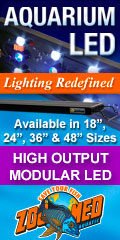seel - I posted the following last year when asked the same question.
IMO some of the Pros & Cons are as follows.
Pros
1. far less carbohydrate than found in many tropical fish foods, which is a good thing as most species of fish can only assimilate so much carbohydrate, especially terrestrial based plant matter such as corn, soybean, etc.
2.Better vitamin/mineral supplementation than a lot of the commercial foods out there.
3. A "soft & moist" food with a water content of approx 20% which equates to being more palatable to some fussy eaters. This also makes feeding easier for those that don't have the skills or patience to pellet train more finicky fish with more dense/dry pellets. I have never had any issues with this, but I realize that some people do.
Cons
1. Limited ingredients in many of the formulas. As an example, the Central/South American formula contains no aquatic plant matter, which is odd, as most of the CA/SA species would consume at least some plant matter on a regular basis, even those classified as being carnivorous. (via the stomach content of their prey) Apparently New Era's work-around for this is to feed several of their formulas on a rotation basis. I'm not too sure that the vast majority of consumers are going to want to follow that type of feeding regime, but hey, what do I know - I'm a nutrition nerd, not a marketing genius.
2. Very high Ash content, quite frankly the highest that I have ever seen, even when including some of the cheapest foods that come out of Asia. Approx 20% Ash content across the board in all of their formulas, and this is with 20% water content in the food - remove 50% of the water to equal the moisture content in most other dry foods, and that ash content would be even higher! Part of this would be due to utilizing less starch/carbs in their formulas, which tends to push up all of the other numbers, the rest I can only assume comes from the fish/shrimp ingredients. As an example, when ingredients such as fish meal are derived from processing plant waste (which is very common in the fish food industry) it typically has a very high ash content due to the fish meal being mostly comprised of heads, bones, and scales. Essentially the leftover "racks" of the fish, vs a fish meal such as Herring meal which is comprised of the "whole" fish. The same would apply if one was using leftover shrimp parts, vs whole krill.
3. High moisture content. This can definitely be a pro when training fish to eat a pellet as soft food is generally more palatable. The downside is that the consumer is paying for that water (anyone can pre-soak their own pellets if they feel the need), and if the food isn't stored properly it has the potential to spoil much easier. With higher moisture content there is a higher risk of mold, and rancidity of fat, unless that food contains a significant amount of synthetic preservatives, such as ethoxyquin, BHA, BHT, etc, yet I see no preservatives listed in the New Era specs? Hmmmmm. The shelf life is listed as 2 years, so something beyond just natural tocopherols (such as vitamins C & E) must be allowing a shelf life of 2 years.
The entire "low temp" cooking process is a bit of a farce, as any company could state they use low temps. There is no industry standard with regards to low temp extrusion in pet foods. I've seen commercial pet foods cooked at 90C referred to as "low temp". When I enquired about New Era's extrusion temps one of the top New Era reps in the UK responded by basically saying that he could not tell me the exact temps.
BTW - interesting name that they chose, don't you think?
"New Era" .... "New Life". Probably just a coinkydink.









